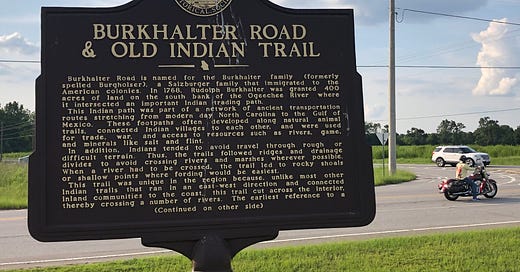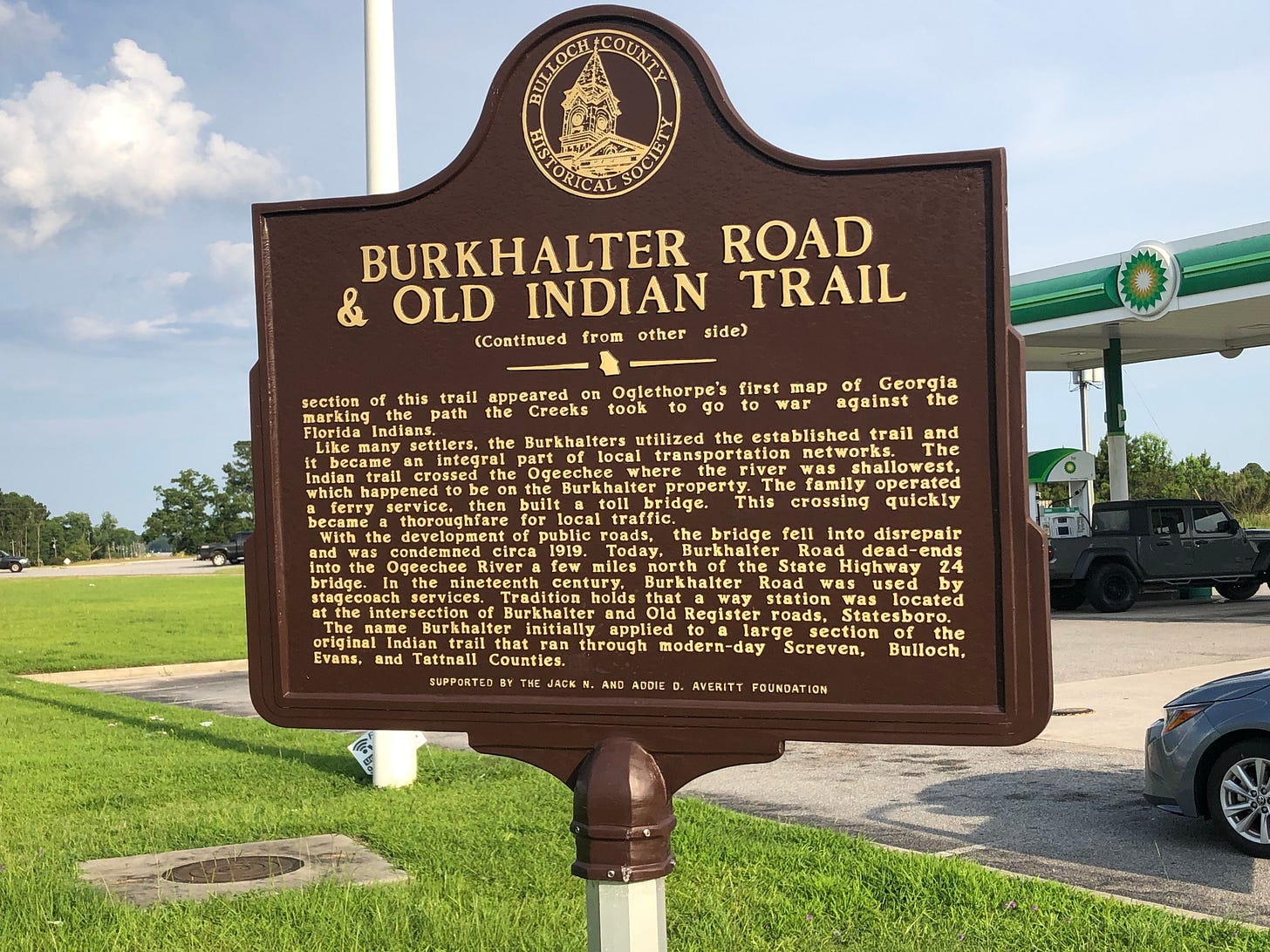The Burkhalter Road: Colonial Georgia's I95, Conclusion!
In 1751, after mounting pressure from the British government and the people of the colony, the Trustees relinquished control of Georgia, and it became a Crown or Royal colony under the control of the British government. With these, major changes came to Georgia such as the introduction of slavery in the colony, and the beginnings of a planter gentry. Also, this meant a different relation with the Indians than that the colonists due to ceded lands being opened to settlement, and this affected the Burkhalter Road!
As the 1750’s continued, and just prior to the French and Indian War breaking out in 1757, the Royal government ceded Creek lands, the eastern portion of southeast Georgia’s Wiregrass region that today includes Screven, Bulloch, Evans counties, etc.., and opened them to settlement by colonists. While the region would not become more heavily settled until after the Revolutionary War, there were some colonists who did venture about 60 miles inland pushing up the rivers and old Indian trails into that area to set up homesteads and etch out a living based on agriculture, trade, and hunting. It was also during this time that the colony had parishes created, these would eventually become the first Georgia counties during the Revolutionary War!
In 1767 (some sources say 1768), a German Salzburger colonist by the name of Rudolph Burgholzer, received a land grant along the Ogeechee River near Hagin’s Bridge in what is now Bulloch County but was then St. Phillip Parish.1 He settled next to the old Indian path which at that time was known as the King’s Road (Burkhalter) and set up a toll bridge. He eventually widened the road and made it more accessible for horse and cart traffic; hence it became known as Burgholzer’s or Burkhalter’s Road!
The above images of the historical plaque along this old road in Bulloch County were taken by the blogger. The Plaques were placed there by the Bulloch County Historical Society.
With Rudolph’s alterations the trail no doubt saw an increase in traffic, which would include by then horse and buggy, making it easier for more settlers to come in and settle along the Ogeechee, Savannah, and Canoochee Rivers, and their various tributaries. The late 1760’s and early 1770’s was a time of crisis in the colonies however, and Georgia was no exception. Because of the expenses heaped onto the British government during the French and Indian War, Britian needed a way to fill her coffers, so George III and his ministers began to tax heavily the American colonies without representation in Parliament. Aside from the taxes, other issues such as the quartering of British soldiers in the homes of colonists raised serious concerns.
Whereas the other 12 colonies joined the colonial cause led by the New England colonies less reluctantly, Georgia was very reluctant to join, and very divided. It had only been a little over 40 years since Oglethorpe had landed at Yamacraw Bluff, and there were many older colonists, many of which were in leadership positions, that felt a strong loyalty to George III, and to the mother country, many of their children and grandchildren however, particularly in Liberty County, and some other pockets of the coast, and the Backcountry were very much on board with the Patriot cause, and things finally came to head when in 1775 with fighting breaking out in Massachusetts between Patriot militia and British troops. A battle took place in Savannah that year between fortified Patriots on Salters Island (site of Old Fort Jackson today), and British troops who had mounted cannons disguised as rice shipments on barges and ended up bombarding the fortification into submission. This battle became known as the Battle of the Rice Boats.
Between 1775 and 1777 other battles would take place at locations such as St. Simons Island, and Fort Beards Bluff among others and things came to a head in 1777 when Georgia’s Patriot governemnt issued an edict expelling all Loyalists out of the state. This included Loyalists who lived near the Burkhalter Road, and Patriot leaders such as William Cone, the Fighting Parsons would travel down this road to drive them out, and no doubt the Loyalists would take it to leave Georgia, either to the coast to board ships bound for other colonies or for Britian itself, or into the British loyalist haven of Florida, which Britian gained from Spain in the French and Indian War.
In 1779 and 1780 the high water marks of the Revolution in Georgia would take place with the disasterous Patriot defeats at Savannah and Augusta. It would not be until late in the war, in 1782 that Patriot forces coming out of the Carolinas under the leadership of General Anthony “Mad Anthony” Wayne would cross the Savannah and launch a campaign to take back portions of Georgia from the British. It was during that year that the Patriots successfully recaptured Savannah from Britain, after being occupied by them beginning in 1778, and the Patriots failing to capture it alongside French troops in 1779. It was also that year that fierce fighting in the neighboring Wiregrass region was occurring, and there was one incident involving William Cone in which the Burkhalter Road would play a major role.
According to accounts a group of Loyalist raiders had taken goods from Patriot settlers in what is now Bulloch County and had made their way southwards towards Florida with the goods, taking the Burkhalter Road. Cone, hearing of this, gathered his men and chased after them taking the road through what is now Bulloch, Evans, and Tattnall counties until he met up with them at an area on the Ohoopee near today’s Reidsville known as “the Rocks,” where he engaged them, driving them across the river while salvaging the goods and returning them to the settlers. This was one of the last engagements in the area.
The war ended in 1783 with America gaining her independence. It would not be the end for the old road though, it would continue to render its services into the 19th century until most of it became phased out as other roads were made with only portions of it retaining its original name and course, in Bulloch County particularly where it is a major landmark. Many in Bulloch County are very proud of this road and the role it played in the development of our state and country, and rightfully so!
Roger Allen, “The History of Burkhalter Road.” Statesboro Herald, No Date.





